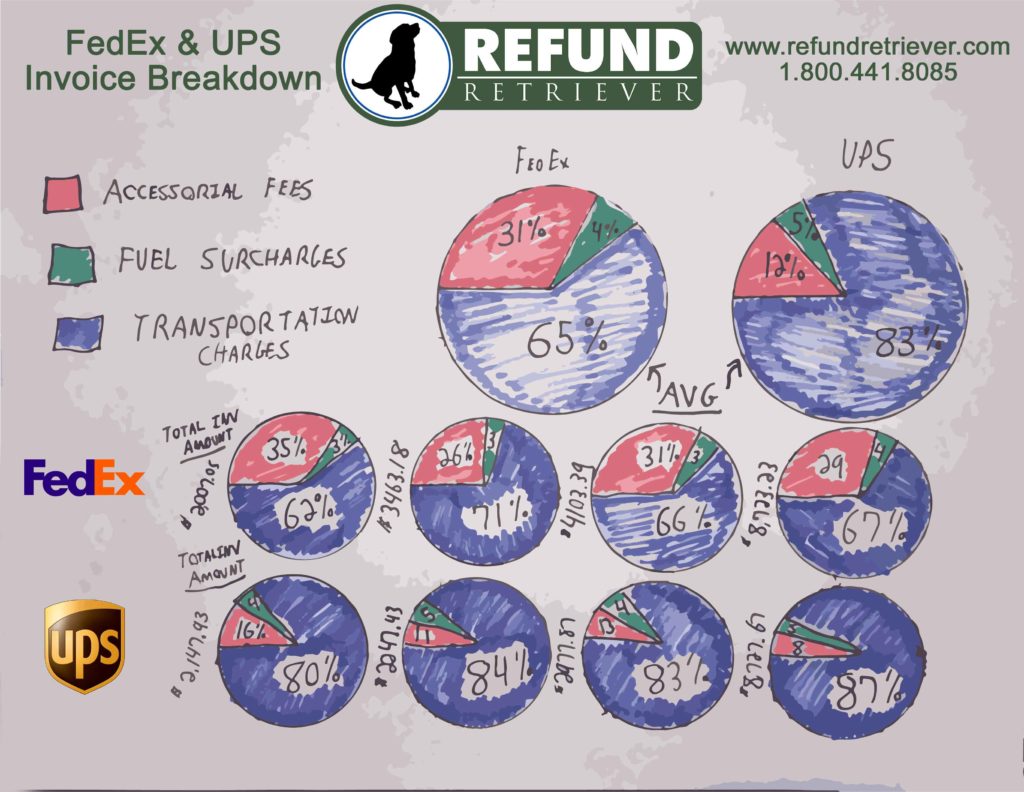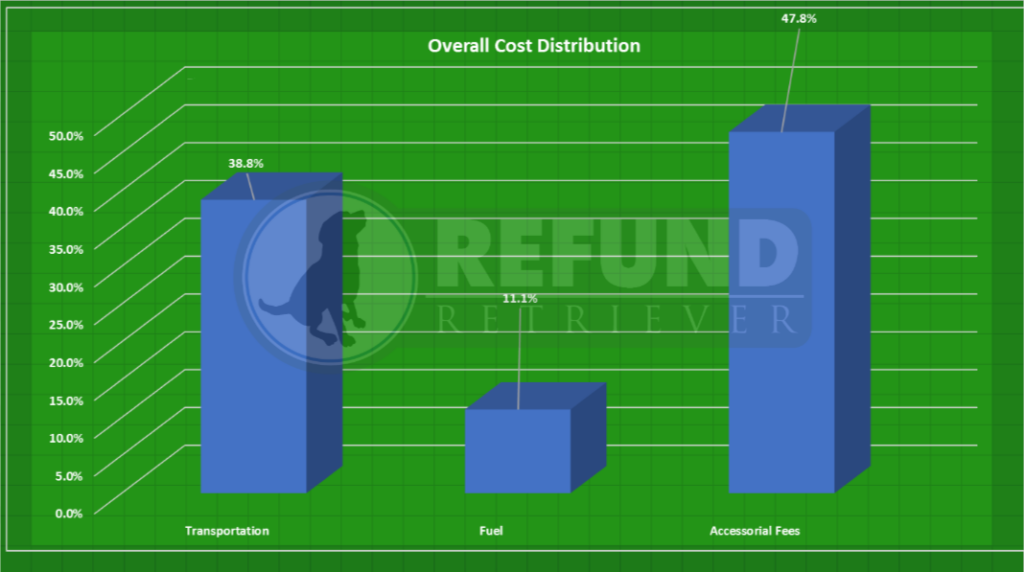Shipping fee surcharges for additional, supplemental, or value-added services can easily account for up to 40 percent of your overall FedEx or UPS invoice costs. After doing some research with our data, we found something interesting. FedEx invoices consistently have a higher percentage of accessorial fees over similar-sized UPS invoices. Our random sample data for FedEx produced a 25 to 35 percent accessorial fee cost from the invoice total. UPS invoices produced an 8 to 16 percent accessorial fee cost from each invoice. The chart below will show many invoices we split into three categories: transportation charges, fuel surcharges, and accessorial fees.
This leads us to another question. Does FedEx charge more fees as a whole, or are the fees charged just more expensive than UPS? This is a topic we will explore in depth down the road. Fuel surcharges are also a key component of your accessorial charges. It will typically account for 3 to 6% of the total invoice cost, as you can see from our sample data.
Where to Start with Shipping Fees
The initial step is to quantify the financial impact of accessorial or value-added surcharges on your invoices. How much of your yearly shipping cost goes to additional fees?
Your shipping data is the best weapon to reduce the budget-busting impact of these additional charges. Refund Retriever’s free logistic reporting, included with our parcel audit, can determine what accessorial charges have the largest cost of transportation impact.
Logistics reporting can reveal shipping intelligence that will save your company money on FedEx and UPS shipping. Whether it’s a UPS audit or a FedEx audit, you’ll see that there are more than 100 of these accessorial charges, comprising roughly 10 to 40 percent of your overall shipping costs.
How do I Reduce FedEx Shipping Fees?
FedEx accessorial fees are additional charges that can be applied to a shipment beyond the basic shipping rate. These fees can be for various services or conditions, such as residential deliveries, address corrections, fuel surcharges, and more. Here are some steps and strategies you can consider to reduce or avoid these fees:
- Know the Fees: Familiarize yourself with FedEx’s accessorial fee schedule. Understanding what fees might apply to your shipments will help you avoid unexpected charges.
- Accurate Addressing: Ensure that all shipping addresses are accurate and complete. Address correction fees can be avoided by simply double-checking the addresses before shipping.
- Use FedEx Tools: FedEx offers tools like Address Validation to help verify the accuracy of addresses.
- Educate Your Customers: If you’re running an e-commerce business, make sure your customers provide complete and accurate shipping information. Include prompts on your website to remind customers to double-check their addresses.
- Residential vs. Commercial: Residential deliveries often incur additional fees. If possible, ship to a commercial address or consider alternative delivery options like FedEx Hold at Location.
- Schedule Pickups: If you’re frequently shipping, consider scheduling regular pickups rather than requesting one-time pickups, which can come with additional fees.
- Package Properly: Oversized or improperly packaged items can incur additional fees. Ensure you’re using the right type of packaging and that your items aren’t exceeding size or weight limits.
- Consider Your Timing: If you don’t need a package to be delivered urgently, avoid using express services. Opt for ground or slower services to save on shipping costs.
- Negotiate Your Rates: If you have a high volume of shipments or have been a long-time FedEx customer, you might be able to negotiate some of your rates or fees. It doesn’t hurt to have a conversation with your FedEx representative about potential discounts or waivers.
- Monitor Invoices: Regularly check your FedEx invoices to ensure you’re not being wrongly charged with any fees. If you notice any discrepancies, contact FedEx to resolve the issue.
By implementing some or all of these strategies, you can potentially reduce FedEx accessorial fees you incur when shipping with FedEx. Remember, every bit saved adds up over time, especially for businesses with regular shipping needs.
All shipping fees charges are negotiable.
Yes, shipping surcharges are often negotiable, especially for businesses that have significant shipping volumes or have established a long-term relationship with the carrier. Here are some points to consider when trying to negotiate shipping surcharges:
- Volume Matters: Carriers are often more willing to negotiate with high-volume shippers. If you ship a significant number of packages or have a consistent shipping schedule, you have a better chance of negotiating surcharges.
- Relationship Longevity: If you’ve been a loyal customer of a specific carrier for years, that loyalty can be leveraged during negotiations.
- Know the Surcharges: Before negotiating, ensure you understand all the surcharges that apply to your shipments. This will help you pinpoint which ones are affecting your bottom line the most.
- Competitive Quotes: If you can get a quote from a competing carrier that offers a better deal, you can use this as a negotiating point with your current carrier.
- Ask for a Dedicated Representative: Having a dedicated account representative from the carrier can be beneficial. They are often empowered to give discounts or negotiate rates to keep valuable customers.
- Consolidate Shipments: Offer to consolidate your shipments if it makes logistical sense. This can make your account more profitable for the carrier, giving you more leverage in negotiations.
- Contractual Commitments: If you’re willing to enter a longer-term contract or commit to a certain volume of shipments, carriers might be more flexible with their surcharges.
- Regular Reviews: As your business grows or as shipping patterns change, regularly review your shipping costs and renegotiate as necessary.
- Use Third-party Negotiators: There are companies and consultants that specialize in negotiating shipping rates and surcharges. If you’re not comfortable negotiating on your own, or if you want an expert’s touch, consider hiring a third-party negotiator.
- Stay Informed: Carriers regularly update their surcharge structures. By staying informed about these changes, you can anticipate potential cost increases and renegotiate terms if necessary.
Remember, everything in business is typically negotiable to some extent. The key is demonstrating value to the carrier and approaching the negotiation with data, understanding, and a clear idea of what you hope to achieve.
Since 2006, Refund Retriever’s parcel audit refund technology has been providing business shippers the transportation insight they need to reduce logistics and freight spending. We thoroughly understand today’s complex carrier pricing environment and have helped large and small business shippers achieve best-in-class pricing.



